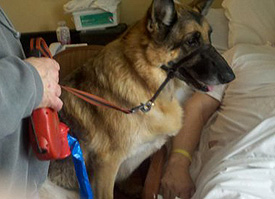MVMA's Minnesota Hall of Fame Professional Award 2013
| Click the letter for a pdf | ||
| Dr. Garlie's letter of nomination | Dr Janice to the MVMA | Dr. Rick Goullaud Compliments |
THE STORY OF CAPTAIN MAXWELL III 
Captain Maxwell: An Emotional Support Dog (AKA MAX)
Emotional Support Dogs are a category of trained working dogs that assist mental health providers in a variety of settings. Max has accompanied me to my psychotherapy office for nearly 10 years starting when he was 9 weeks old. During that time he has “shepherded” many through difficult times: the loss of loved ones, divorce, depression, anxiety, and terminal illness to name but a few. He knows sooner than do I if someone is about to cry. He  knows who wants kisses and who would like him to keep his distanceChildren and teens are captivated by Max, often spending whole sessions on the floor with him while talking openly with me. It is not uncommon for folks to pet Max throughout an entire session as he snuggles up to them on the couch. Max will calm those who are hyper and energize those who have low energy. Besides all of his office duties Max is my constant companion and comforter through sad and difficult times.
knows who wants kisses and who would like him to keep his distanceChildren and teens are captivated by Max, often spending whole sessions on the floor with him while talking openly with me. It is not uncommon for folks to pet Max throughout an entire session as he snuggles up to them on the couch. Max will calm those who are hyper and energize those who have low energy. Besides all of his office duties Max is my constant companion and comforter through sad and difficult times.
Captain Maxwell Battles Megaesophagus
I am telling Max’s story on this page because many dogs die every year from undiagnosed Megaesophagus (ME). ME is a condition in which dogs become  unable to swallow. If they are not diagnosed and treated immediately death occurs in a very short time. Unfortunately, many vets do not recognize this condition. With adequate treatment Megaesophagus dogs can live relatively normal lives. Max was diagnosed more than two years ago and he is still working full time. Max insists that I tell you his story in hopes of saving the lives of some of his four legged friends.
unable to swallow. If they are not diagnosed and treated immediately death occurs in a very short time. Unfortunately, many vets do not recognize this condition. With adequate treatment Megaesophagus dogs can live relatively normal lives. Max was diagnosed more than two years ago and he is still working full time. Max insists that I tell you his story in hopes of saving the lives of some of his four legged friends.
Megaesophagus (ME) is a condition in which the esophagus becomes enlarged and incapable of moving liquids into the stomach. It is not uncommon for ME dogs to regurgitate (spit up, not vomit) undigested food 7-8 times a day and/or night. ME is most readily diagnosed by a Barium Swallow in which the dysfunction of the esophagus can be clearly seen. ME is most commonly caused by autoimmune diseases or Myasthenia Gravis.
 In Captain Maxwell’s case ME was caused by an autoimmune disease. Max had become deathly ill, gaunt and skeletal. His eyes drooped in a most pathetic way. After four days in intensive care and multiple tests, the vet recommended a x-ray and dap Barium Swallow. We watched the radiographic film as the barium Max had swallowed pooled in his esophagus. Next the vet had given him a large meatball and as it entered his esophagus it scooped up the barium and emptied it into his stomach. We had both our diagnosis and a way to keep him alive. Needless to say, I felt both relieved and hopeful.
In Captain Maxwell’s case ME was caused by an autoimmune disease. Max had become deathly ill, gaunt and skeletal. His eyes drooped in a most pathetic way. After four days in intensive care and multiple tests, the vet recommended a x-ray and dap Barium Swallow. We watched the radiographic film as the barium Max had swallowed pooled in his esophagus. Next the vet had given him a large meatball and as it entered his esophagus it scooped up the barium and emptied it into his stomach. We had both our diagnosis and a way to keep him alive. Needless to say, I felt both relieved and hopeful.
Treatment of ME dogs involves frequent feeding (5-6 times a day) of small amounts of wet solid food. ME dogs must be kept in a vertical position while eating and for 20-30 minutes after eating so the food moves into the stomach by gravity. One popular method of maintaining a dog in a vertical position is to use a Bailey Chair. Donna and Joe Koch of California designed the chair to save their ME dog, Bailey. The Bailey Chair has saved the lives of many ME dogs in this country and overseas. You can find a number of YouTube videos of dogs being fed in Bailey Chairs.
You may learn much more about Megaesophagus and the Bailey Chair at http://pets.groups.yahoo.com/group/megaesophagus/ where over 6,000 people with ME dogs share their knowledge and support.
